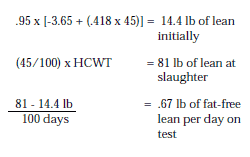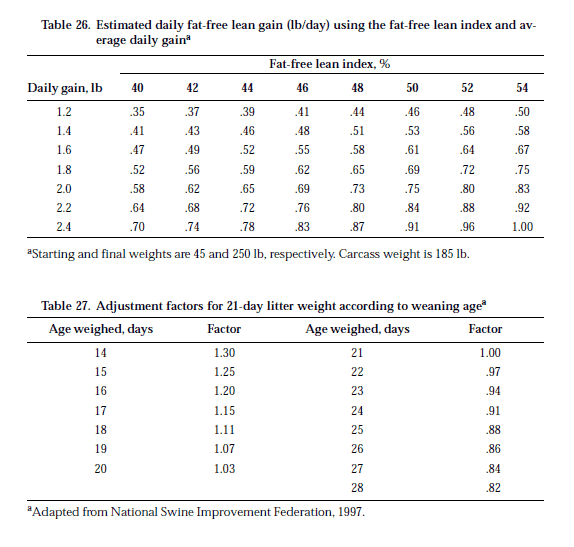Swine Nutrition Guide: Tools for Quantifying Performance
Tools for Quantifying Performance -- We have provided nutrient recommendations based on fat-free lean growth rate, 21-day litter weight and feed intake in this publication. These factors influence the quantity of nutrients pigs require. By monitoring pig performance, it is possible to formulate diets to specific production situations and reduce the consequences of underfeeding or overfeeding nutrients. This section will describe tools to use in quantifying pig performance. The procedures involve feeding high nutrient dense diets to a sample of pigs to evaluate their performance when dietary nutrient density is not likely a limiting factor. Once the performance potential of the pigs is known, diets can be formulated.
How do I estimate fat-free lean growth rate?
There are several methods to measure lean growth in swine. First, you can determine the quantity of lean in the pig initially and in the carcass at slaughter and the number of days on test. Use the following formula to estimate rate of fat-free lean gain:

Final pounds of lean in the carcass can be obtained by using the lot average for fat-free lean index (FFLI) and hot carcass weight. This information is provided on packer kill sheets in the Nebraska and South Dakota area. The FFLI is the percentage of edible, lean meat in a carcass, factoring out intramuscular fat (i.e., marbling). Because the FFLI adjusts lean content to represent no intramuscular fat, it will normally be 5 to 7% less than customary percent lean values. Daily lean gain using the FFLI results in lean gain with 0% fat, therefore the values will be lower than lean gain expressed on a 5% fat basis.
Use the following formula to estimate pounds of lean in the carcass:
lb of lean = (FFLI/100) x HCWT
where
FFLI = fat-free lean index
HCWT = hot carcass weight, lb
To estimate pounds of fat-free lean in a 40 to 50 lb pig use the following equation:
lb of fat-free lean initially = .95 x [-3.65 + (.418 x live wt, lb)]
For example, assume that a group of pigs averaging 45 lb initially was tested for 100 days. At slaughter, the group average for hot carcass weight and FFLI was 180 lb and 45, respectively. What is the average fat-free lean growth rate for the group?

A second and quicker method of estimating fat-free lean gain is shown in Table 26.

Find the pigs' FFLI across the top of the table and average daily gain on the left side. For example, a group of pigs having a FFLI of 45 and an average daily gain of 2.0 lb/day will have an estimated fat-free lean gain of .66 lb/day from 45 to 250 lb. The most accurate method to measure the lean growth of your herd is to determine the lean growth curve of your growing-finishing pigs.
This involves a minimum of five ultrasonic scannings at specific intervals throughout the growth phase on a representative sample of pigs. Also, feed intake measurements must be obtained throughout the growth phase. The scan data and feed intake data are then sent to Purdue University where the specific lean growth curve for individual farms are generated. While this is the most costly method, it also provides one of the greatest opportunities to formulate diets for a given level of performance The equations for calculating the FFLI are being revised as this publication goes to press.
We used the FFLI provided by the National Pork Producers Council in 1994 as the basis for the feeding recommendations in this publication. Farm-specific feeding programs for growing-finishing pigs are best established by conducting growth trials. Do this by randomly selecting 10 to 20 % (equal numbers of each sex if separate sex feeding is not practiced on the farm) of the pigs from a farrowing group for each test. Pigs should weigh between 40 and 50 lb at the beginning of the test. Weigh the pigs and manage them normally to market weight.
To ensure that nutrient intake is not limiting lean growth, feed diets containing 10% higher amino acid levels than those shown for high lean gain pigs in Tables 12 and 13. Terminate the test when the pigs average about 250 lb. Repeat the test quarterly during the first year and semiannually thereafter. Record feed disappearance so nutrient intake can be estimated. Information should be available from at least three tests before a final decision is made regarding whether to classify the pigs as high, medium or low lean gain.
What is the best way to obtain 21-day litter weights?
Litters should be standardized to between 8 and 10 pigs per litter within 24 to 48 hours after birth. Collect litter weights before weaning and as near 21 days of age as possible. Litters may be weighed between 14 and 28 days and the weights adjusted to a 21-day basis (Table 27). For example, a litter weighed 120 lb at 19 days of age. The 21-day litter weight would be 128.4 lb (120 x 1.07). If creep feed is offered, it is important that litter weights be obtained by 21 days of age to minimize the influence of creep feed intake on 21-day litter weights.
In genetic selection programs the 21-day litter weight is adjusted for parity and number of pigs after transfer. We do not believe these adjustments are necessary to apply the concepts outlined in this publication. Provide groups of lactating sows diets containing 1.15% lysine and collect 21-day litter weights. Repeat the test quarterly during the first year and semiannually thereafter. Record feed disappearance so nutrient intake can be estimated.
Information should be available from at least three tests before a final decision is made regarding whether to classify the sows as capable of producing litters weighing more or less than 120 lb at 21 days of lactation. Amino acid recommendations for lactating sows producing litters weighing less than or greater than 120 lb at 21 days are shown in Table 14.
How can I estimate feed intake?
Producers who operate buildings or rooms on an all-in/all-out basis can use closeout information. Those with continuous flow production are advised to closely monitor identified pens of pigs or groups of sows. To estimate lactating sow feed intake attach a card to each farrowing crate and record the amount of feed added to the sow's feeder daily. General guidelines for daily feed intake of pigs are shown in Tables 11, 12, 13, 14 and 15.
This article hasn't been commented yet.


Write a comment
* = required field